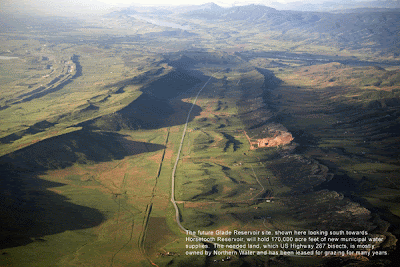A quick look at the draft EIS did not produce any surprises, said Gary Wockner, spokesman for Glade Reservoir opponents, Save the Poudre Coalition. "There's nothing in there that changes our mind that this project will be very bad for the Poudre River," he added. Highlights from the report include:  The Northern Integrated Supply Project's proposed Glade Reservoir would significantly reduce flow of the Cache la Poudre River in peak runoff months. According to the long-awaited Draft Environmental Impact Statement (EIS) released on Wednesday, the proposed reservoir would reduce the Poudre River's flow through Fort Collins by 71 percent in May and more than half as runoff peaks in June.
The Northern Integrated Supply Project's proposed Glade Reservoir would significantly reduce flow of the Cache la Poudre River in peak runoff months. According to the long-awaited Draft Environmental Impact Statement (EIS) released on Wednesday, the proposed reservoir would reduce the Poudre River's flow through Fort Collins by 71 percent in May and more than half as runoff peaks in June.
The Ft. Collins Coloradoan reports that opponents of the project are preparing to dig in to the massive document and its concomitant technical reports. The release begins a 90-day comment period during which the U.S. Army Corps of Engineers will review input from residents and government agencies about the project. Opponents plan to lobby for an extension of the comment period, according to the Coloradoan.
- Building Glade and Galeton (another reservoir) as proposed would cost about $426 million and would be the least-costly alternative.
- Glade would cause the loss of 44 acres of wetlands, the fewest among the alternatives.
- The reservoir would cause the loss of about 2,700 acres of native plant communities, or 20 percent more than other options.
- The reservoir would cause the loss of 50 acres of habitat for the Preble's meadow jumping mouse, which is a designated as a threatened species.
- Most of Glade's water would be taken during times of high flows. Reductions in the river's monthly average flow through Fort Collins would range from 71 percent in May in average years to 26 percent in August in dry years.
- NISP participants currently have access to about 50,000 acre feet of water and are expected to exceed that amount by 2010. With continued population growth, the annual demand for water will reach 90,700 acre feet by 2025.
- Flows on the Poudre and South Platte are likely to be reduced by other proposed water projects, including the expansion of Halligan and Seaman reservoirs, if NISP is built and if it is not.
U.S. Army Corps of Engineers Draft EIS
Photo: Northern Colorado Water Conservancy District





















